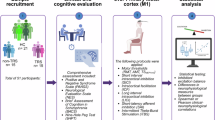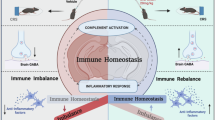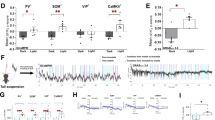Abstract
Vigabatrin increases gamma aminobutyric acid (GABA) levels by irreversible inhibition of the GABA-catabolizing enzyme GABA-transaminase (GABA-T). Preclinical studies suggest anxiolytic effects in vigabatrin treated rats. Anxiolytic effects in patients with panic disorder (PD) could therefore be expected. To evaluate putative anxiolytic properties of vigabatrin in humans, CCK-4–induced panic symptoms were studied in healthy volunteers before and after vigabatrin treatment. After placebo-controlled administration of 50 μg CCK-4, ten healthy volunteers received vigabatrin for seven days with a daily dosage of 2 g. The treatment period was followed by a second CCK-4 challenge. Panic and anxiety were assessed using the Acute Panic Inventory (API) score and a DSM-IV derived panic-symptom-scale (PSS). ACTH and cortisol plasma levels were determined during the CCK-4 challenge. All subjects reported a marked reduction of CCK-4–induced panic symptoms and anxiety after seven days of vigabatrin treatment both in the API- and PSS-scores. Moreover, there was a significant attenuation of CCK-induced elevation of ACTH and cortisol levels following vigabatrin treatment. In conclusion, our data show that GABA-transaminase inhibitors exert anxiolytic effects in CCK-4–induced panic in healthy volunteers and suggest that GABA transaminase inhibitors might be useful in ameliorating panic symptoms also in patients with PD.
Similar content being viewed by others
Log in or create a free account to read this content
Gain free access to this article, as well as selected content from this journal and more on nature.com
or
References
Abelson JL, Nesse RM, Vinik A . (1991): Stimulation of corticotropin release by pentagastrin in normal subjects and patients with panic disorder. Biol Psychiatry 29 (12)): 1220–1223
Ben-Menachem E . (1989): Pharmacokinetic effects of vigabatrin on cerebrospinal fluid amino acids in humans. Epilepsia 30 Suppl 3: S12–S14
Bradwejn J, de Montigny C . (1984): Benzodiazepines antagonize cholecystokinin-induced activation of rat hippocampal neurones. Nature 312: 363–364
Bradwejn J, Koszycki D . (1994b): Imipramine antagonism of the panicogenic effects of cholecystokinin tetrapeptide in panic disorder patients. Am J Psychiatry 151: 261–263
Bradwejn J, Koszycki D . (1994a): The cholecystokinin hypothesis of anxiety and panic disorder. Ann N Y Acad Sci 713: 273–282
Bradwejn J, Koszycki D, Bourin M . (1991a): Dose ranging study of the effects of cholecystokinin in healthy volunteers. J Psychiatry Neurosci 16: 91–95
Bradwejn J, Koszycki D, Meterissian G . (1990): Cholecystokinin-tetrapeptide induces panic attacks in patients with panic disorder. Can J Psychiatry 35: 83–85
Bradwejn J, Koszycki D, Shriqui C . (1991b): Enhanced sensitivity to cholecystokinin tetrapeptide in panic disorder. Clinical and behavioral findings. Arch Gen Psychiatry 48: 603–610
Castro JL, Ricci D, Taira CA, Ramirez A . (1999): Central benzodiazepine involvement in clonidine cardiovascular actions. Can J Physiol Pharmacol 77: 844–851
de Montigny C . (1989): Cholecystokinin tetrapeptide induces panic-like attacks in healthy volunteers. Arch Gen Psychiatry 46: 511–517
Degli Uberti EC, Trasforini G, Margutti AR, Rotola CA, Pansini R . (1983): Effect of pentagastrin on adrenocorticotropin hormone and thyroid-stimulating hormone release in normal subjects. Horm Res 17: 74–77
Dillon DJ, Gorman JM, Liebowitz MR, Fyer AJ, Klein DF . (1987): Measurement of lactate-induced panic and anxiety. Psychiatry Res 20: 97–105
Farmer MR, Vaile JC, Osman F, Ross HF, Townend JN, Coote JH . (1998): A central gamma-aminobutyric mechanism in cardiac vagal control in man revealed by studies with intravenous midazolam. Clin Sci 95: 241–248
Flint AJ, Koszycki D, Bradwejn J, Vaccarino FJ . (2000): Neurohormonal responses to cholecystokinin tetrapeptide: a comparison of younger and older healthy subjects. Psychoneuroendocrinology 25: 633–647
Harden CL . (1994): New antiepileptic drugs. Neurology 44: 787–795
Harro J, Vasar E, Bradwejn J . (1993): CCK in animal and human research on anxiety. Trends Pharmacol Sci 14: 244–249
Holsboer F . (1998): The rationale for corticotropin-releasing hormone receptor (CRH-R) antagonists to treat depression and anxiety. J Psychiatric Res 33: 181–214.
Koszycki D, Zacharko RM, Le Melledo JM, Bradwejn J . (1998): Behavioral, cardiovascular, and neuroendocrine profiles following CCK-4 challenge in healthy volunteers: a comparison of panickers and nonpanickers. Depress Anxiety 8: 1–7
Lancel M, Faulhaber J . (1996): The GABAA agonist THIP (gaboxadol) increases non-REM sleep and enhances delta activity in the rat. Neuroreport 7: 2241–2245
Manuchehri K, Goodman S, Siviter L, Nightingale S . (2000): A controlled study of vigabatrin and visual abnormalities. Br J Ophthalmol 84: 499–505
Nutt DJ, Glue P, Lawson C, Wilson S . (1990): Flumazenil provocation of panic attacks. Arch Gen Psychiatry 47: 917–925
Sayin U, Purali N, Ozkan T, Altug T, Buyukdevrim S . (1992): Vigabatrin has an anxiolytic effect in the elevated plus-maze test of anxiety. Pharmacol Biochem Behav 43: 529–535
Sherif F, Harro J, el-Hwuegi A, Oreland L . (1994): Anxiolytic-like effect of the GABA-transaminase inhibitor vigabatrin (gamma-vinyl GABA) on rat exploratory activity. Pharmacol Biochem Behav 49: 801–805
Sherif F, Oreland L . (1995): Effect of the GABA-transaminase inhibitor vigabatrin on exploratory behaviour in socially isolated rats. Behav Brain Res 72: 135–140
Shlik J, Aluoja A, Vasar V, Vasar E, Podar T, Bradwejn J . (1997): Effects of citalopram treatment on behavioural, cardiovascular and neuroendocrine response to cholecystokinin tetrapeptide challenge in patients with panic disorder. J Psychiatry Neurosci 22: 332–340
Ströhle A, Holsboer F, Rupprecht R . (2000): Increased ACTH concentrations associated with cholecystokinin tetrapeptide-induced panic attacks in patients with panic disorder. Neuropsychopharmacology 22: 251–256
van Megen H, Westenberg HG, den Boer J, Slaap B, Scheepmakers A . (1997): Effect of the selective serotonin reuptake inhibitor fluvoxamine on CCK-4 induced panic attacks. Psychopharmacology 129: 357–364
Wittchen HU, Zhao S, Abelson JM, Abelson JL, Kessler RC . (1996): Reliability and procedural validity of UM-CIDI DSM-III-R phobic disorders. Psychol Med 26: 1169–1177
Zwanzger P, Baghai T, Boerner RJ, Möller H-J, Rupprecht R . (2001): Anxiolytic effects of vigabatrin in panic disorder. J Clin Psychopharmacology (in press).
Acknowledgements
The authors thank Angela Johnson for technical assistance.
Author information
Authors and Affiliations
Corresponding author
Rights and permissions
About this article
Cite this article
Zwanzger, P., Baghai, T., Schuele, C. et al. Vigabatrin Decreases Cholecystokinin-Tetrapeptide (CCK-4) Induced Panic in Healthy Volunteers. Neuropsychopharmacol 25, 699–703 (2001). https://doi.org/10.1016/S0893-133X(01)00266-4
Received:
Revised:
Accepted:
Published:
Issue date:
DOI: https://doi.org/10.1016/S0893-133X(01)00266-4
Keywords
This article is cited by
-
Evaluation of Phytochemicals, Antioxidants, Trace Elements in Kigelia africana Fruit Extracts and Chemical Profiling Analysis Using UHPLC-qTOF-MS2 Spectrometry
Biological Trace Element Research (2020)
-
Effects of experimentally induced panic attacks on neuroimmunological markers
Journal of Neural Transmission (2009)
-
Evaluation of the CCK-4 model as a challenge paradigm in a population of healthy volunteers within a proof-of-concept study
Psychopharmacology (2007)
-
Effects of Alprazolam on Cholecystokinin-Tetrapeptide-Induced Panic and Hypothalamic–Pituitary–Adrenal-Axis Activity: A Placebo-Controlled Study
Neuropsychopharmacology (2003)
-
Die experimentelle Provokation von Panikattacken als humanexperimentelles Angstmodell
Der Nervenarzt (2003)



